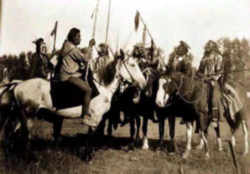


Texas Symbols
Texas Early History
First Early Inhabitants of Texas

Early history examines the archaeological record that tells the story of the first inhabitants of Texas. Learn about the prehistory and culture of the first early inhabitants, and what lessons it might teach us about the early history of Texas.
Texas First Early Inhabitants Timeline
- 225 million BC to 65 million BC - At least 16 types of dinosaurs roamed Texas from 225 million years ago to about 65 million years ago,
at which time dinosaurs disappeared.
Before 11,000-8000 BC
The first immigrants drift into the area now called Texas. Artifacts from pre-historic periods, as well as bones of mammoths, horses, camels, ancient bison, giant short-faced bears and giant armadillos, have been found at the Lubbock Lake Landmark site. - c. 8000-7000 BC - Burials from this era are the earliest so far discovered in Texas: Midland Man, discovered in Midland County in 1953; a female, whose remains were found near Leander in Williamson County in 1983; and the remains of a man and a boy discovered shortly thereafter at a site near Waco.
- c. 4000 BC - People in the lower-Pecos River area leave distinctive rock art painted on cave walls and other rock surfaces.
- 2000 BC - Pecos Culture begins with changes in architecture, art and pottery for the people who lived in a semi-arid environment
- c. 1500 BC - Corn farmers settle near Presidio in an area known as La Junta de los Ríos (the meeting of the rivers) where the Río Grande and Mexico's Río Conchos join. It is believed to be the oldest continuously cultivated farmland in Texas.
- AD 800 - 1500 - Farmers/hunters build and occupy what is today called the Buried City, stone dwellings located southeast of Perryton in Ochiltree County on the northern edge of the Panhandle, as well as other sites along the Canadian River.
- c. 1400 - The Caddo Confederacy establishes a civilization in East Texas based on agriculture.
- 1685 - Texas claimed by Rene-Robert Cavelier, Sieur de La Salle (1643-1687) for France
- 1803 - The United States bought the Louisiana Territory from France for 15 million dollars for the land
1820 - The Texas–Indian wars (1820 - 1875) were a series of conflicts between settlers in Texas and Plains Indians.
Early History of Native Americans in Texas
The Indigenous People of Texas
The names of the Texas tribes included the Apache, Alabama, Atakapa, Biloxi, Caddo, Cherokee, Choctaw, Comanche, Creeks, Koasati, Koroa, Kiowa, Pueblos, Quapaw, Shawnee, Waco, Wichita and Zuni. Some of these tribes migrated to the Great Plains.
Evidence of human habitation in the area now known as Texas dates back roughly 11,000 years. Archaeologists have found this evidence by looking at several types of sites, including camp sites where people lived; quarries where people cut away stone to use as tools; kill-sites, with evidence of hunters and the remains of their prey, and cave painting sites. For example, a site in Val Verde County, Texas, contains the bones of a large number of bison, along with fragments from the weapons used to kill them and tools used to cut away the meat. This cave dates to nearly 10,000 years ago.
The earliest people who lived in Texas were there during the late stages of the Ice Age. Scientists can identify them by the kind of weapons they made for hunting. By around 6000 BC, there is evidence that people were shifting away from a life focused on hunting and gathering, to a more settled agricultural society. We know this from the discovery of tools used for grinding grain to be used for food. From around 1,000 BC, we find evidence of large numbers of people being buried in ritualized ways, by using burial mounds, which indicates a substantial growth in the population in the area. Sometime around 1,000 AD, there begins to be evidence of long-distance trade in the use of materials that are not native to the area, and must have been acquired through contact with groups of people living some distance away.
The "historical" period in Texas begins with the first visits to the area by Europeans, specifically the Spanish and the French. There is also evidence that tribal groups from other parts of North America, such as the Comanche and the Apache, also came to Texas. By the early 18th century, the influence of these groups had substantially changed life for the original inhabitants of the area.





